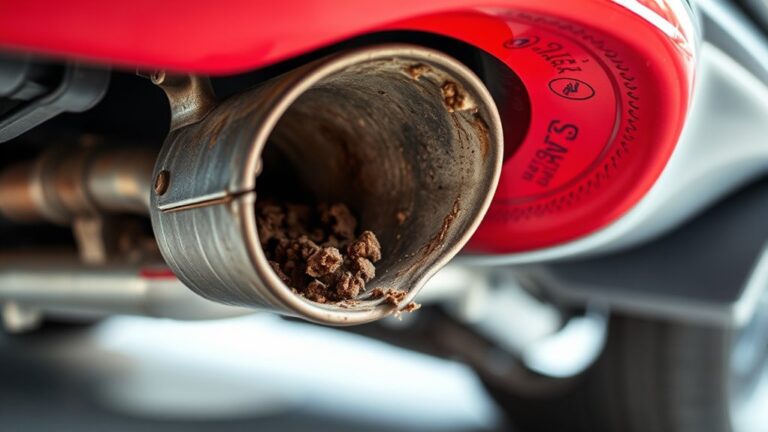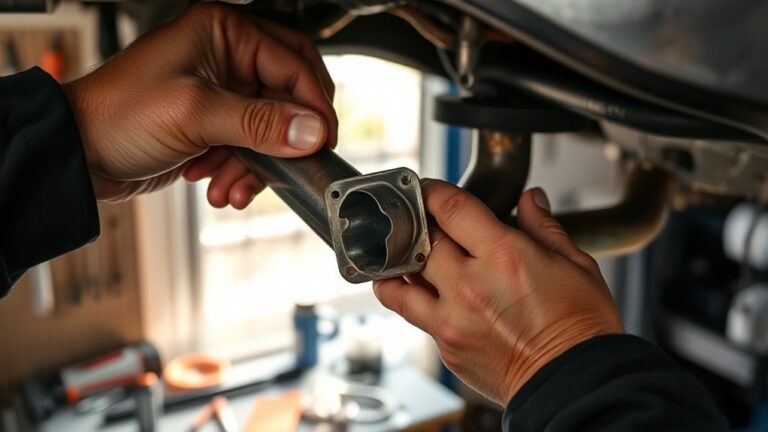Cost Guide: Fixing Low Transmission Fluid at Home Vs Shop
When fixing low transmission fluid, doing it yourself can cost between $60 and $170, depending on the fluid type and tools needed. In contrast, professional services typically range from $100 to $200, influenced by your vehicle’s make and model. DIY allows for cost savings and improved performance, while professional help guarantees quality and safety. Knowing your skills can guide your choice. To get a clearer picture of the process, you’ll find more insights below.
Understanding Transmission Fluid: Importance and Types

When you consider the health of your vehicle’s transmission, understanding the role of transmission fluid becomes essential. Transmission fluid acts as a lubricant, coolant, and hydraulic fluid, guaranteeing smooth operation and longevity. Different transmission types—automatic, manual, and continuously variable—require specific fluid characteristics tailored to their unique needs.
For automatic transmissions, fluid must offer excellent thermal stability and friction properties to facilitate gear changes. In manual transmissions, you’ll find a thicker fluid designed to provide better lubrication and protection against wear. Continuously variable transmissions (CVTs) utilize specialized fluids, enabling them to function seamlessly across varying gear ratios.
Choosing the right type of fluid is critical for maintaining performance and avoiding costly repairs. Always consult your owner’s manual for the recommended fluid type and specifications to guarantee your vehicle’s transmission operates efficiently and reliably. Understanding these factors empowers you to make informed decisions regarding your vehicle’s maintenance.
DIY Transmission Fluid Change: Costs and Considerations

Maintaining the correct level and quality of transmission fluid is essential for peak performance, and performing a DIY transmission fluid change can be a cost-effective solution. The fluid replacement benefits include improved shifting, enhanced lubrication, and extended transmission life. However, it’s imperative to avoid common mistakes, such as using the wrong fluid type or failing to properly dispose of old fluid.
Here’s a cost breakdown to help you plan:
| Item | DIY Cost Estimate | Shop Service Cost Estimate |
|---|---|---|
| Transmission Fluid | $30 – $80 | $100 – $200 |
| Tools (if needed) | $20 – $50 | N/A |
| Gasket/Filter | $10 – $40 | Included |
| Total Estimate | $60 – $170 | $100 – $200 |
Professional Transmission Fluid Service: Pricing Breakdown

Professional transmission fluid services typically range from $100 to $200, depending on various factors such as the vehicle make, model, and service provider. When evaluating service pricing, it’s vital to account for your vehicle’s specific transmission type, as some may require specialized fluids or procedures. Additionally, labor costs can vary greatly based on the shop’s location and expertise.
You’ll also want to assess the scope of the transmission maintenance. Basic fluid changes might fall on the lower end of the price spectrum, while extensive services that include filter changes and system flushes could push costs higher. Shops may also offer warranties on their work, which can add value to the service. Ultimately, investing in professional transmission fluid service guarantees your vehicle runs smoothly, prolonging its lifespan and enhancing performance.
Tools and Equipment Needed for Home Repairs
For successful home repairs involving low transmission fluid, having the right tools and equipment at your disposal is crucial. You’ll want to make sure you’re fully equipped to tackle this task efficiently and safely. Here’s a list of four must-have items:
- Transmission Fluid Pump: This helps you transfer fluid smoothly, preventing spills.
- Socket Set: A variety of sizes will allow you to remove and replace pan bolts or other components.
- Fluid Catch Pan: Necessary for collecting old fluid, keeping your workspace clean.
- Funnel: To pour new transmission fluid into the reservoir without mess.
With these tools, you can confidently perform home repairs on your vehicle’s transmission fluid. Making certain you’ve got the right equipment not only makes the job easier but also enhances your freedom to maintain your vehicle effectively.
Evaluating Your Skills: When to DIY vs. Seek Professional Help
Having the right tools is just the start of handling low transmission fluid issues. Before diving into a DIY fix, conduct a thorough skill assessment. Consider your mechanical knowledge, experience with similar tasks, and comfort level with potential challenges. If you’ve successfully tackled fluid changes before, you might be equipped to handle this task. However, if your skills are limited or you’ve faced complications in the past, seeking professional advice is wise.
Professional mechanics possess specialized tools and diagnostic equipment that can identify underlying problems beyond just fluid levels. They can also guarantee that the repair adheres to safety standards. Remember, your time and vehicle’s reliability matter. If you’re uncertain about your ability to complete the job correctly, don’t hesitate to consult a professional. Balancing independence with the need for expertise is key to making the right decision for your automotive needs.
Frequently Asked Questions
How Often Should I Check My Transmission Fluid Levels?
You should check your transmission fluid levels at least once a month as part of your transmission maintenance routine. Regular fluid inspection helps guarantee your vehicle operates smoothly and prevents potential damage. Look for signs of discoloration or a burnt smell, which could indicate a problem. If you frequently drive under extreme conditions, consider checking more often. Keeping an eye on fluid levels can save you from costly repairs down the road.
Can Low Transmission Fluid Cause Engine Damage?
Yes, low transmission fluid can cause engine damage. When fluid levels drop, it compromises lubrication, leading to increased friction and heat, which can negatively affect engine performance. Poor fluid maintenance can result in overheating, gear slippage, and ultimately, engine failure. It’s essential to regularly check your transmission fluid levels to guarantee peak performance and prevent costly repairs. Taking proactive steps in fluid maintenance can save you from significant engine-related issues down the road.
What Are the Signs of a Transmission Fluid Leak?
You might notice a stark contrast between smooth gear shifts and abrupt changes if your transmission fluid is leaking. Key transmission symptoms include visible fluid spots under your vehicle, a burning smell, or erratic shifting. Fluid indicators like low transmission fluid levels and unusual noises can further confirm a leak. Keeping an eye on these signs guarantees you maintain your vehicle’s performance, giving you the freedom to drive without worry.
Is It Safe to Drive With Low Transmission Fluid?
No, it’s not safe to drive with low transmission fluid. Low levels can lead to inadequate lubrication, resulting in increased friction and potential damage to your transmission. This jeopardizes transmission safety, heightening driving risks like slipping gears or complete failure. If you notice signs of low fluid, such as overheating or strange noises, it’s best to address the issue immediately to prevent costly repairs and guarantee your vehicle operates smoothly.
How Do I Properly Dispose of Old Transmission Fluid?
To properly dispose of old transmission fluid, you should first transfer it into a sealed fluid container. This prevents leaks and contamination. Next, locate a nearby recycling center that accepts automotive fluids. Many auto parts stores also provide recycling services. Never pour it down drains or on the ground, as it can harm the environment. By following these steps, you guarantee safe disposal while contributing to a more sustainable future.







